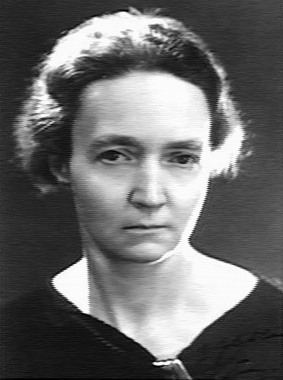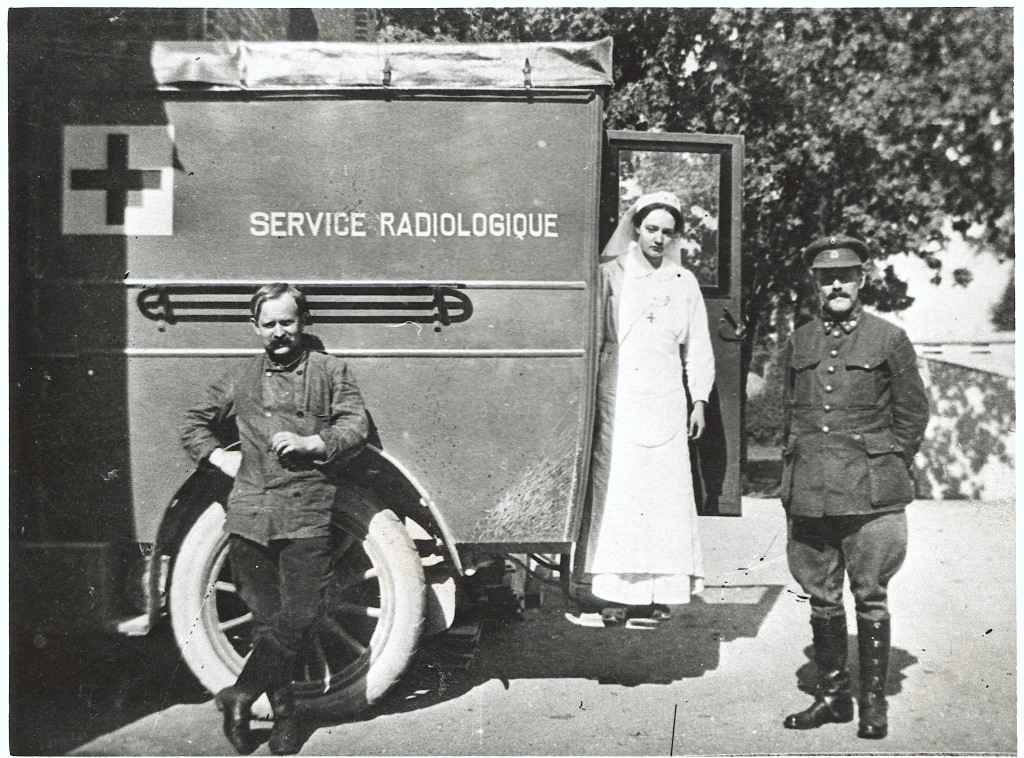Irène Curie (1897-1956) was the youngest daughter of Pierre and Marie Curie. She followed her parents into the laboratory spending her career studying radioactivity. Hers was a glittering scientific career from PhD to lecturer then from lecturer to Professor and finally director of the Radium Institute. She also, like her parents, won a Nobel prize – this one in 1935 with her husband Frédéric Joliot. Irène’s was an amazing life, but a life cut short, in part, due to her work in the First World War as a medical X-ray technician.

Irène was born in Paris on 12th September 1897. It was a unconventional childhood. Aged 10 she was taken out of school was tutored at home as part of ‘The Cooperative’ – educational group organised by scientists living in Paris at the time. The scientists took it in turn to teach one another’s children in their homes. They not only taught science and maths, at which Irène excelled, but also encouraged creativity, self-expression, and play. After two years with the The Cooperative Irène went to the College Sevigne and then to the famous Parisian college, The Sorbonne.
When WW1 broke out Irène was an undergraduate in the Faculty of Science at the Sorbonne. Aged 17 she was initially taken to the countryside for safety but she was soon back with her mother training to become an X-ray radiographer. She not only worked in the field X-raying injured soldiers but also helped her mother train new radiographers. How did she end up doing this work? Well, that was down to her mother.
By the start of WW1 many hospitals in France already had X-ray equipment. Unfortunately, those machines were far from the battlefield and so of little use to battlefield doctors trying to locate broken bones and remove the bullets and shrapnel embedded in soldiers’ bodies. Marie Curie’s solution was a vehicle containing an X-ray machine and photographic darkroom equipment – a “radiological car”. She envisaged these vehicles being driven right up to the battlefield where army surgeons could use X-rays to guide their surgeries.
Marie struggled to get funding from the French military so instead approached wealthy friends, colleagues, and philanthropic organisations to raise money for the X-ray vehicles and equipment. By October 1914, the first of the petites Curies (little Curies) was ready and ended up playing an important role in treating the wounded at the Battle of Marne in 1914 – a major Allied victory that kept the Germans from entering Paris. In all 20 of these vehicles were built.
But to say that she helped her mother is to greatly understate the situation. The need was so great that they worked independently of each other. Irène went to the front to set up, repair, and operate the units. Often they were used during surgery to help locate shrapnel in the body. When she wasn’t at the front trying to convince experienced military surgeons that a teenaged girl knew more about x-rays and geometry than they did, she was training other technicians. In spite of spending her eighteenth birthday alone at the front, she seems to have handled this time with composure and a confidence that is rare, although her mother never doubted her. Irène later said, “My mother had no more doubts about me than she had about herself.”

After the war Irène became an assistant to her mother at the Laboratoire Curie of the Institut du Radium in Paris before going on to complete her PhD.
Unfortunately, the early X-ray equipment gave the operators large doses of X-ray radiation. So, when Marie Curie died in 1934 at age 66 of aplastic anemia she attributed this to the radiation exposure she received when operating the mobile X-ray units. It is thought that Irène’s eventual death from leukemia aged just 58 was also due, in part, to her work in those X-ray units.
References
Unfortunately, I have not been able to find a lot of information about Irène’s time as a technician. I will keep looking and hopefully I’ll be able to write more in the future. For now, the main sources I have used in writting this are:
- Chadwick, J., Obituary – Mme. Irène Curie, Nature, May 26, .964-965, (1956)
- http://www.rsc.org/diversity/175-faces/all-faces/irene-joliot-curie/
- https://www.nobelprize.org/prizes/chemistry/1935/joliot-curie/facts/
- http://theinstitute.ieee.org/tech-history/technology-history/how-marie-curie-helped-save-a-million-soldiers-during-world-war-i
- https://theconversation.com/marie-curie-and-her-x-ray-vehicles-contribution-to-world-war-i-battlefield-medicine-83941
- https://sheroesofhistory.wordpress.com/2015/01/15/irene-joliot-curie/
- https://saintssistersandsluts.wordpress.com/2012/08/12/irene-joliot-curie-for-the-joy-of-science/
One thought on “Irène Curie”